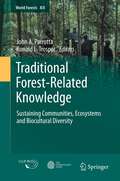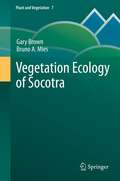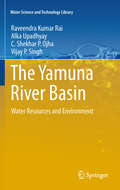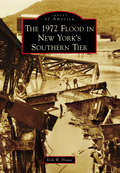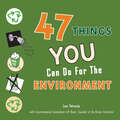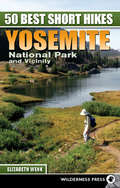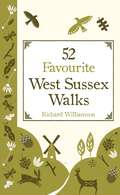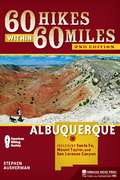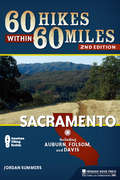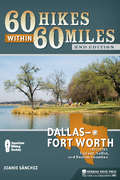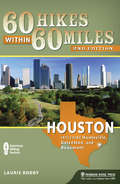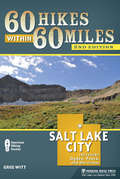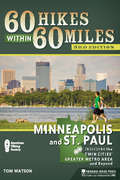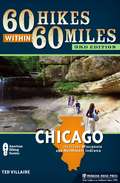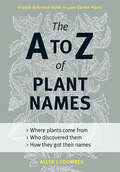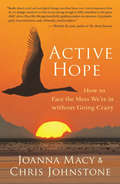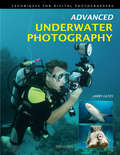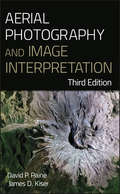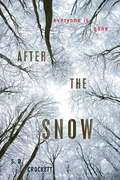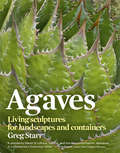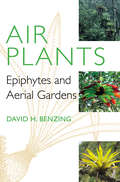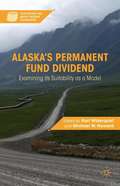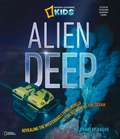- Table View
- List View
Traditional Forest-Related Knowledge
by John A. Parrotta Ronald L. TrosperExploring a topic of vital and ongoing importance, Traditional Forest Knowledge examines the history, current status and trends in the development and application of traditional forest knowledge by local and indigenous communities worldwide. It considers the interplay between traditional beliefs and practices and formal forest science and interrogates the often uneasy relationship between these different knowledge systems. The contents also highlight efforts to conserve and promote traditional forest management practices that balance the environmental, economic and social objectives of forest management. It places these efforts in the context of recent trends towards the devolution of forest management authority in many parts of the world. The book includes regional chapters covering North America, South America, Africa, Europe, Asia and the Australia-Pacific region. As well as relating the general factors mentioned above to these specific areas, these chapters cover issues of special regional significance, such as the importance of traditional knowledge and practices for food security, economic development and cultural identity. Other chapters examine topics ranging from key policy issues to the significant programs of regional and international organisations, and from research ethics and best practices for scientific study of traditional knowledge to the adaptation of traditional forest knowledge to climate change and globalisation.
Vegetation Ecology of Socotra
by Bruno Mies Gary BrownAlthough the unique flora of the Socotra Archipelago with its high degree of endemism has received much attention recently, little information is available on the vegetation and related ecological aspects. Based on their extensive field experience of the region, the authors have assimilated a vast amount of knowledge to produce this book, which gives a detailed insight into the plant ecology of Socotra, designated as a World Heritage Site by UNESCO in 2008. The book is divided into seven chapters. After a brief introduction and overviews of important abiotic features, various aspects of the vascular flora are presented in Chapter 4, together with accounts of the bryophyte and lichen flora. Ecology and adaptive strategies of the plants are dealt with in Chapter 5, and Chapter 6 gives a concise description of the main vegetation units. Finally, important management issues of the vegetation are discussed, an essential topic to ensure preservation of the natural heritage of the archipelago.
The Yamuna River Basin
by Alka Upadhyay C. Shekhar Ojha Raveendra Kumar Rai Vijay P. SinghThis book is designed to provide concepts, methodologies, and approaches for river basin studies with respect to water resources and environment. The book is not limited to the Yamuna River basin, but will help in the study of various other river basins for integrated water resources management. The book covers the essential components of integrated water resources management, including analysis of climatic variables, climate change detection, analysis of natural resources, geology, geomorphology, socio-economics, water budgeting, flood estimation, river pollution, etc. Furthermore, the book addresses recent issues pertaining to water quality, water quality indices, environmental flows, water resources management through cropping pattern change, etc. along with methodologies and application to the Yamuna River system. However, the main objective of this book is to address important issues of water resources management of river basins. Audience: The manuscript has been designed so that it can be used as a reference for river basin studies. The book will be useful to engineers, agricultural scientists, environmentalists, planners, managers, and administrators who are concerned with water resources.
1972 Flood in New York's Southern Tier, The (Images of America)
by Kirk W. HouseIn June 1972, Hurricane Agnes hit the East Coast with a monstrous and devastating force, bringing a deluge across multiple states and slamming four counties in the Southern Tier: Steuben, Chemung, Tioga, and Broome. Dozens died and property damage ran into the millions as Corning, Elmira, Owego, Binghamton, and other communities suddenly found themselves under water. The flood destroyed the Erie Lackawanna Railroad, staggered the Penn Central, shut down Corning Glass Works for weeks, and devastated the Corning Museum of Glass--a major cultural resource. Lives and landscapes were forever changed when homes and businesses washed away in a matter of minutes. Henceforth, the region's history became permanently divided into the times before and the times after the 1972 flood. Through stunning images, The 1972 Flood in New York's Southern Tier chronicles the extraordinary destruction of twisted rail lines, devastated streets, exhausted recovery workers, rivers bursting their banks, cars on houses, and houses on cars, all while capturing the communities' rebuilding efforts and recovery of the glass museum treasures.
47 Things You Can Do for the Environment
by Lexi Petronis Jill BuckSure, we all know the planet is in trouble. We hear talk all the time about climate change, air pollution from cars, oil spills into oceans, trash overflowing into waterways, and toxic chemicals leaking into our groundwater. Sigh. But the good news is there’s a lot we can do to start cleaning up the Earth. And it starts with you!
50 Best Short Hikes: Yosemite National Park and Vicinity
by Elizabeth Wenk50 Best Short Hikes: Yosemite National Park and Vicinity leads hikers of all skill levels to some of the most stunning landscapes Yosemite has to offer including: bubbling alpine creeks, smooth glaciated slabs, giant sequoias, deep dark blue lakes, and rock as far as the eye can see. In addition to in-depth hike descriptions, the author has also included information about the parks natural history, complex landscape, and its human history. Additional information includes tips on keeping yourself and your family safe, the park's natural predators, and helpful weather information.
52 Favourite West Sussex Walks
by Richard WilliamsonRichard Williamson’s weekly walking column is one of the most popular features in the Chichester Observer, Worthing Observer and West Sussex Gazette. Now he has compiled his favourite walks – one for every week of the year. With hand-drawn route maps and practical notes, these routes can be covered easily in an afternoon.
52 Favourite West Sussex Walks
by Richard WilliamsonRichard Williamson’s weekly walking column is one of the most popular features in the Chichester Observer, Worthing Observer and West Sussex Gazette. Now he has compiled his favourite walks – one for every week of the year. With hand-drawn route maps and practical notes, these routes can be covered easily in an afternoon.
60 Hikes Within 60 Miles: Albuquerque
by Stephen AushermanThis newly updated and revised edition of 60 Hikes within 60 Miles: Albuquerque hits classic trails and uncovers paths where no guidebook has gone before. This is the essential guide to north-central New Mexico, from the black lava badlands in El Malpais National Monument to the cool aspens in Santa Fe National Forest. Explore newly opened lands in the Ojito Wilderness and the Valles Caldera, or revisit the past with nostalgic walks along the Rio Grande and Route 66. Hikes lead to ancient pueblos, ghost towns, slot canyons, strange hoodoos and other treasures in the heart of New Mexico, all just a daytrip or less from the Duke City.Each chapter serves as both a navigational aide and an interpretive guide to familiarize hikers with wondrous destinations in the Land of Enchantment. From the black lava badlands in El Malpais National Monument to the aspen trees in Santa Fe National Forest, the Albuquerque area is filled with beautiful wilderness perfect for exploration. This comprehensive guidebook outlines the level of difficulty for each hike, and includes extensive maps and trail profiles to assist hiking enthusiasts and day-trippers alike. Experience the Rio Grande, old Route 66, ancient pueblos, ghost towns, and other charms of the area with this essential guide.
60 Hikes Within 60 Miles: Sacramento
by Jordan SummersCarefully researched on foot, hiking enthusiast Jordan Summers introduces area residents and visitors to an array of the best day hikes from casual riverside nature hikes to rugged foothill treks within roughly an hour's drive of Sacramento.Filled with detailed descriptions of firsthand trail notes, this newly updated edition of 60 Hikes Within 60 Miles: Sacramento helps hikers discover their choices with concise at-a-glance information highlighting details such as location, access, directions, distances, scenery, and preparation details that help hikers get the most from each outing. Precise maps, descriptive text, photos, and trailhead coordinates guide you on your way quickly and keep you on route reliably. Discover the varied geology, the cultural history, and the natural beauty of the foothills, mother lode, and delta regions in 60 Hikes Within 60 Miles: Sacramento.
60 Hikes Within 60 Miles: Dallas/Fort Worth
by Joanie Sanchez60 Hikes within 60 Miles: Dallas / Fort Worth covers the best trails the metroplex has to offer, including popular trails as well as lesser-known paths no guidebook has covered before. This is the essential guide you'll need for hiking in the Dallas / Fort Worth Metroplex. Choose a trek alongside ancient dinosaur tracks at Dinosaur Valley State Park, or follow fresh prints of live coyote and white-tailed deer at Lake Mineral Wells. Explore remnants of Texas' disappearing blackland prairie, or wander amongst the dense hardwood forests of the riparian wetlands. A hike for every mood, you can pick a quiet hike to a secluded pecan grove or an upbeat populated hike to a State Champion Oak Tree - or maybe you just want to feel like a pioneer as you hike through the wilderness of the LBJ National Grasslands. Hikes include treks through open prairies, rolling hillsides, lakeside beaches, and other treasures all found just a daytrip or less from the Dallas / Fort Worth Metroplex.
60 Hikes Within 60 Miles: Houston
by Laurie Roddy60 Hikes within 60 Miles: Houston uncovers hikes around Houston that previously had gone unnoticed. This is the essential guide to this area, from the Big Thicket of east Texas to the coast of Galveston Island. Explore most of the 138-mile Lone Star Trail with over a dozen hikes breaking up the trail into manageable segments. Hikes lead to old native homesteads, native prairies, deep forests, riparian woodlands, urban byways, wildlife preserves along the Great Texas Coastal Birding Trail, wetlands, and numerous bayous and waterways. Each chapter serves as both a navigational aide and an interpretive guide to familiarize hikers with wondrous destinations in and around The Bayou City.
60 Hikes Within 60 Miles: Salt Lake City
by Greg Witt60 Hikes Within 60 Miles: Salt Lake City is the only guidebook that pinpoints the most exceptional hikes in the area. It contains meticulous trail descriptions that range from comfortable strolls for families to difficult treks for those looking for a challenging workout. Extensive key-at-a-glance information makes it easier to choose a hike based on length, difficulty, or scenery. A helpful list of hikes in the front of the book highlights those with special interests - best hikes for children, scenic hikes, hikes good for wildlife viewing, best hikes for runners, and more. Each hike report includes commentary on trailside geology, flowers, and wildlife. Historical notes provide fascinating details about early miners, trailblazers, the Pony Express, and Mormon pioneers.Nestled in the western flank of the Rockies, Salt Lake City provides ready access to a stunning array of hiking options amid alpine lakes, snow-draped mountain peaks, fragrant evergreen forests, deep canyon waterfalls, granite towers, and flowered cirques. Within 60 miles of Salt Lake City there are thousands of square miles of national forest, National Wilderness Areas, state parks and designated recreation areas to explore.Now, with this updated edition of 60 Hikes within 60 Miles: Salt Lake City, whether lacing up boots, stepping into sneakers or strapping on snowshoes, Salt Lake City is even more accessible for hikers.
60 Hikes Within 60 Miles: Minneapolis and St. Paul
by Tom WatsonWithin the seven county "metro" area that encompasses the Twin Cities of Minneapolis and St. Paul lies a network of hundreds of miles of trails. Hikes were selected to be representative of the area, showcasing the park or region's main attractions or personality. Some of these trails are broad, paved corridors through multi-use parks generously developed to provide a myriad of recreational opportunities for the young and old, the robust trekker, and the casual stroller.Trails are based in a wide range of areas such as walkways of grass winding through majestic stands of Minnesota hardwoods. Other hikes are spider-web networks that remind one of well-used deer trails. Some are isolated within a pocket of greenery surrounded by vast ribbons of freeway concrete and broad subdivisions. Others are woven within the fabric of parklands so expansive that you could literally spend weeks hiking all the networks lying within their folds. Twin Cities' hiking is huge so get the guide that gets you there and back.This decisive guide to day hikes in the Twin Cities' area just got better. Updated maps, new hikes, new photos, and brand-new trailhead coordinates make Tom Watson's authoritative guide even more useful than before.
60 Hikes Within 60 Miles: Chicago
by Ted VillaireIn addition to Chicago's numerous cultural and athletic activities, there are many excellent opportunities to explore Mother Nature's bounty. From the dunes of Lake Michigan to the hills and lakes of the northwest to the prairies of the south, hikers will find a trail to their liking in this updated edition of 60 Hikes within 60 Miles: Chicago.Hikes were chosen for their scenic appeal, but they were also chosen for their historic attractions. The extensive key-at-a-glance information makes it a snap to choose a hike based on length, difficulty, and scenery. Helpful lists highlight the best hikes for children, for wildlife viewing, and other categories.Whether a long-time Chicago resident or vacationer to the area, this updated guide will make choosing the right hike easy and enjoyable.
The A to Z of Plant Names: A Quick Reference Guide to 4000 Garden Plants
by Allen J. CoombesBotanical names can be baffling to even the most experienced gardener. But a plant's botanical name is more than just a handy label—it can tell a plant's country of origin, the shape of its leaves, the color of its petals, and much more. The A to Z of Plant Names clears the confusion and allows every gardener to name plants with confidence. This comprehensive yet handy guide features the botanic names of the plants that gardeners really grow. Additional information includes suggested pronunciation, the common name, the derivation of the scientific name, the number of species currently accepted, the type of plant and the distribution. The A to Z of Plant Names helps demystify names, provides readers with the intriguing background information to naming conventions, and empowers gardeners everywhere to feel confident about naming plants.
Active Hope
by Joanna Macy Chris JohnstoneThe challenges we face can be difficult even to think about. Climate change, the depletion of oil, economic upheaval, and mass extinction together create a planetary emergency of overwhelming proportions. Active Hope shows us how to strengthen our capacity to face this crisis so that we can respond with unexpected resilience and creative power. Drawing on decades of teaching an empowerment approach known as the Work That Reconnects, the authors guide us through a transformational process informed by mythic journeys, modern psychology, spirituality, and holistic science. This process equips us with tools to face the mess we're in and play our role in the collective transition, or Great Turning, to a life-sustaining society.
Advanced Underwater Photography
by Larry GatesDesigned for photographers who already have strong diving skills and understand basic photographic techniques, this reference defines what advanced underwater photography is while teaching the skills necessary to create professional-quality images. Opening with a quick overview of the basics--such as exposure, focus, subject selection, and composition--the author then expands on each of these topics, showing the techniques pros use to achieve truly stunning images. A major factor in advancing beyond the basic level of underwater photography is moving from a point-and-shoot or semi-adjustable camera to using a full-featured digital SLR camera. The myriad equipment choices available when making this transition--including cameras, lenses, underwater housings, and the lighting units designed to be used with them--are explained, as are their respective advantages and shortcomings. Because both beginning and advanced underwater photographers can have equipment-related issues, a trouble-shooting section is included to ensure that minor equipment problems won't ruin a costly dive trip.
The Adventures of Robinson Crusoe
by Daniel Defoe"Robinson Crusoe" is about an adventurer who is shipwrecked on a desert island, The book contains adventure of all sorts: pirates, shipwrecks, cannibals, mutiny, and so much more... The book was written by Daniel Defoe and was first published in 1719.
Aerial Photography and Image Interpretation
by James D. Kiser David P. PaineThe new, completely updated edition of the aerial photography classicExtensively revised to address today's technological advances, Aerial Photography and Image Interpretation, Third Edition offers a thorough survey of the technology, techniques, processes, and methods used to create and interpret aerial photographs. The new edition also covers other forms of remote sensing with topics that include the most current information on orthophotography (including digital), soft copy photogrammetry, digital image capture and interpretation, GPS, GIS, small format aerial photography, statistical analysis and thematic mapping errors, and more. A basic introduction is also given to nonphotographic and space-based imaging platforms and sensors, including Landsat, lidar, thermal, and multispectral. This new Third Edition features:Additional coverage of the specialized camera equipment used in aerial photographyA strong focus on aerial photography and image interpretation, allowing for a much more thorough presentation of the techniques, processes, and methods than is possible in the broader remote sensing texts currently availableStraightforward, user-friendly writing styleExpanded coverage of digital photographyTest questions and summaries for quick review at the end of each chapterWritten in a straightforward style supplemented with hundreds of photographs and illustrations, Aerial Photography and Image Interpretation, Third Edition is the most in-depth resource for undergraduate students and professionals in such fields as forestry, geography, environmental science, archaeology, resource management, surveying, civil and environmental engineering, natural resources, and agriculture.
After The Snow (After The Snow #1)
by S. D. CrockettThe oceans stopped working before Willo was born, so the world of ice and snow is all he's ever known. He lives with his family deep in the wilderness, far from the government's controlling grasp. Willo's survival skills are put to the test when he arrives home one day to find his family gone. It could be the government; it could be scavengers--all Willo knows is he has to find refuge and his family. It is a journey that will take him into the city he's always avoided, with a girl who needs his help more than he knows.
Agaves: Living Sculptures for Landscapes and Containers
by Greg StarrGardeners and garden designers are having a love affair with agaves. It's easy to see why—they're low maintenance, drought-tolerant, and strikingly sculptural, with an astounding range of form and color. Many species are strikingly variegated, and some have contrasting ornamental spines on the edges of their leaves. Fabulous for container gardening or in-the-ground culture, they combine versatility with easy growability. In Agaves, plant expert Greg Starr profiles 75 species, with additional cultivars and hybrids, best suited to gardens and landscapes. Each plant entry includes a detailed description of the plant, along with its cultural requirements, including hardiness, sun exposure, water needs, soil requirements, and methods of propagation. Agaves can change dramatically as they age and this comprehensive guide includes photos showing each species from youth to maturity—a valuable feature unique to this book.
Air Plants: Epiphytes and Aerial Gardens
by David H. BenzingOften growing far above the ground, "air plants" (or epiphytes) defy many of our common perceptions about plants. The majority use their roots only for attachment in the crowns of larger, usually woody plants-or to objects such as rocks and buildings-and derive moisture and nutrients from the atmosphere and by collecting falling debris. Only the mistletoes are true parasites. Epiphytes are not anomalies and there are approximately 28,000 species-about 10 percent of the higher or vascular plants-that grow this way. Many popular houseplants, including numerous aroids, bromeliads, ferns, and orchids, rank among the most familiar examples. In Air Plants, David H. Benzing takes a reader on a tour of the many taxonomic groups to which the epiphytes belong and explains in nontechnical language the anatomical and physiological adaptations that allow these plants to conserve water, thrive without the benefit of soil, and engage in unusual relationships with animals such as frogs and ants.Benzing's comprehensive account covers topics including ecology, evolution, photosynthesis and water relations, mineral nutrition, reproduction, and the nature of the forest canopy as habitat for the free-living and parasitic epiphytes. It also pays special attention to important phenomena such as adaptive trade-offs and leaf economics. Drawing on the author's deep experience with epiphytes and the latest scientific research, this book is accessible to readers unfamiliar with technical botany; it features a lavish illustration program, references, a glossary, and tables.
Alaska’s Permanent Fund Dividend
by Karl Widerquist Michael W. HowardContributors discuss the Alaska Permanent Fund (APF) and Permanent Fund Dividend (PFD) as a model both for resource policy and for social policy. This book explores whether other states, nations, or regions would benefit from an Alaskan-style dividend. The book also looks at possible ways that the model might be altered and improved.
Alien Deep: Exploring The Mysterious World Of Hydrothermal Vents (National Geographic Science And Nature Series)
by Bradley Hague National Geographic Kids StaffAppealing to children over age ten, this engaging reference book depicts adventurous and thrilling elements in oceanographic fieldwork. In conjunction with a National Geographic television show, this book will reach a huge audience of marine lovers, as well as children interested in science and exploration. <P><P> Alien Deep outshines the competition by following a recent, specific deepwater exploration that illuminates new knowledge about our oceans. Following alongside a current expedition, Alien Deep will enable children to observe the processes involved in marine exploration. As scientists delve into the mysterious depths of the ocean, children will be able to witness the excitement of scientific exploration and discovery through enriching text and stunning photography. By describing a recent exploration, children will be able to read and see the new methods and technology that oceanographers use to conduct research.
